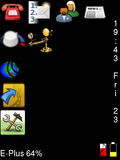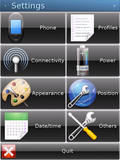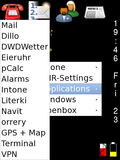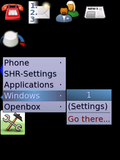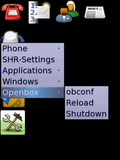Minimoko
From Openmoko
Contents |
Minimoko: fast and lean Desktop
--matzehuber 16:30, 27 October 2009 (UTC)
I used shr unstable with all updates until 2009-10-15 and made some changes on it.
- windowmanager: openbox and obconf (patched few lines of code)
- desktop-software(icons): idesk
- keyboard: literki
- screenlock: xtrlock (modified)
- desktop-status: xminimokostatus (new written, uses dbus in C/glib)
Screenshots
left side screenshots are with normal theme, the right theme is "Mikachu"
Download
- Full Image [1]http://www.huber-computer.de/openmoko/minimoko.tbz (~80 MB)
- Diff between shr-u and Minimoko: [2]http://www.huber-computer.de/openmoko/minimoko_diff.tbz (~13 MB)
- Update-Package from 1. Version to actual [3]http://www.huber-computer.de/openmoko/minimoko_update.tbz (~1 MB)
Install
untar it onto an ext3-sdcard. nothing more is to do. boot with qi. you need ~243 MB on the card.
Documentation Links
- openbox: http://icculus.org/openbox/index.php/Main_Page
- obconf: http://icculus.org/openbox/index.php/ObConf
- idesk: http://idesk.sourceforge.net/wiki/index.php/Main_Page
Usage
It bases on shr, so the base is shr-like. If you want to get illume, just rename .Xsession to .Xsession.unused
Tips
- When you use obconf, the configuration is "copied" into .config/openbox/rc.xml and furthermore used from there
- Minimized Windows are excluded from the slide function, you have to bring them up with menu -> windows
- To bring the keyboard up, slide from bottom right up and slide down to bring it down
- one can have the icons moveable, but the screen is flickering while moving. to do this, one can edit .ideskrc
Knobs, touches ...
- single click on an icon starts the program which lays behind .idesktop/<application>.lnk
- AUX locks the screen with xtrlock. Pressing one more AUX unlocks the screen
- POWER short pressed suspends
- POWER for more or equal 2 Seconds shuts the system down with init 0
- Slide(drag to the right, for example) on the top bar of an application switches to the next application
- Double Click on the topbar of an application shows the Main Menu
- Double Click on the empty desktop shows the Main Menu
- On the left of the topbar is the knob for minimizing the app, on the right topbar is the close knob
Menus
if you installed new applications and want the menu updated, use:
/usr/bin/makemenus
after that, you can remove unused menuitems in /etc/xdg/openbox/openmoko.menu
Sources / Patches / Binaries
- openbox needed to have a little patch because of the behavior of the om-applications: client.patch and prompt.patch
- NEW VERSION: client_new.patch prompt-patch not more needed. With this patch openbox is able to hadle rotated display with xrandr.
- xminimokostatus can be found here: xminimokostatus.tgz. it is now also able to handle rotated display. Lic: GPL_newest
- the patched xtrlock can be found here: xtrlock-2.0_patched.tgz
- idesk binary: idesk-0.7.5_0.1_armv4t.ipk sourcedir with compiled binary: idesk-0.7.5.tbz
- not more used: i wrote a little helper, which places text on the root window: xroottext.tgz Lic: GPL_newest

